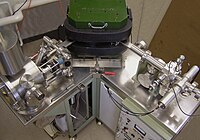
Photo from wikipedia
We used stable isotopes to determine spatial and temporal patterns of suspended kelp-derived detritus (KDD) along a Macrocystis kelp abundance gradient driven by recovering sea otter (Enhydra lutris) populations along… Click to show full abstract
We used stable isotopes to determine spatial and temporal patterns of suspended kelp-derived detritus (KDD) along a Macrocystis kelp abundance gradient driven by recovering sea otter (Enhydra lutris) populations along the west coast of Vancouver Island. Three dominant kelp species (order Laminariales) and surface marine size-fractionated particulate organic matter (POM) were sampled along offshore transects (0–30 km) within three regions during summer and winter. Nearshore phytoplankton isotope values were identified in regions with high chlorophyll a concentrations. Summer blooming phytoplankton δ13C values were enriched by 2.4‰ and 0.8‰ and δ15N was enriched by 1.2‰ and 0.3‰ for 20–63 μm and 0.7–20 μm POM, respectively. Macrophyte stable isotope values varied significantly within and among regions, as well as between seasons. Primary producer values were used in a Bayesian isotope mixing model (MixSIR) to estimate the KDD contribution to POM. In general, the kelp abundant region had a greater contribution of KDD to POM further away (from 4 km to 30 km) from the kelp forest (range of medians 7–58%) compared to the kelp sparse region (4–30%). Seasonally, the KDD contribution to 20–63 μm POM size fractions was greater during summer (33% average) compared to winter (16% average). These results indicated that kelp abundance is not the only driver of KDD dispersal spatially and temporally. Factors such as local oceanography, large variation in kelp isotope values, and similarity between kelp and shelf phytoplankton isotope values affect these patterns and lead to high uncertainty in modeled KDD contributions.
Journal Title: Limnology and Oceanography
Year Published: 2017
Link to full text (if available)
Share on Social Media: Sign Up to like & get
recommendations!